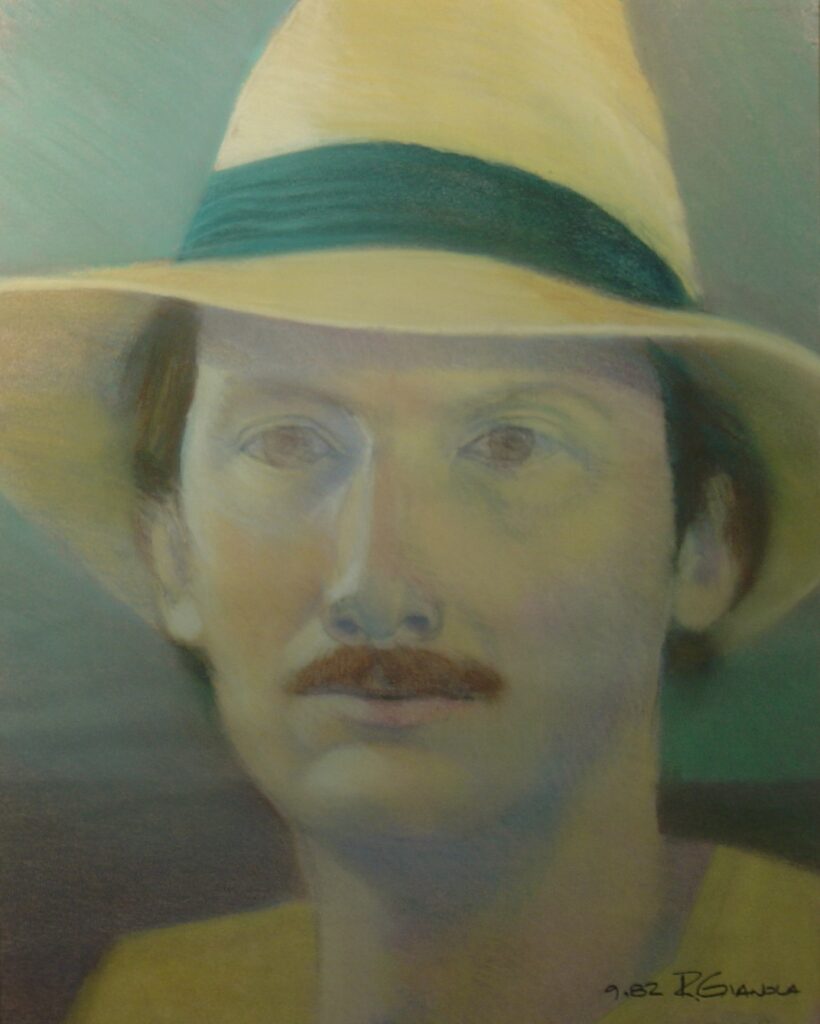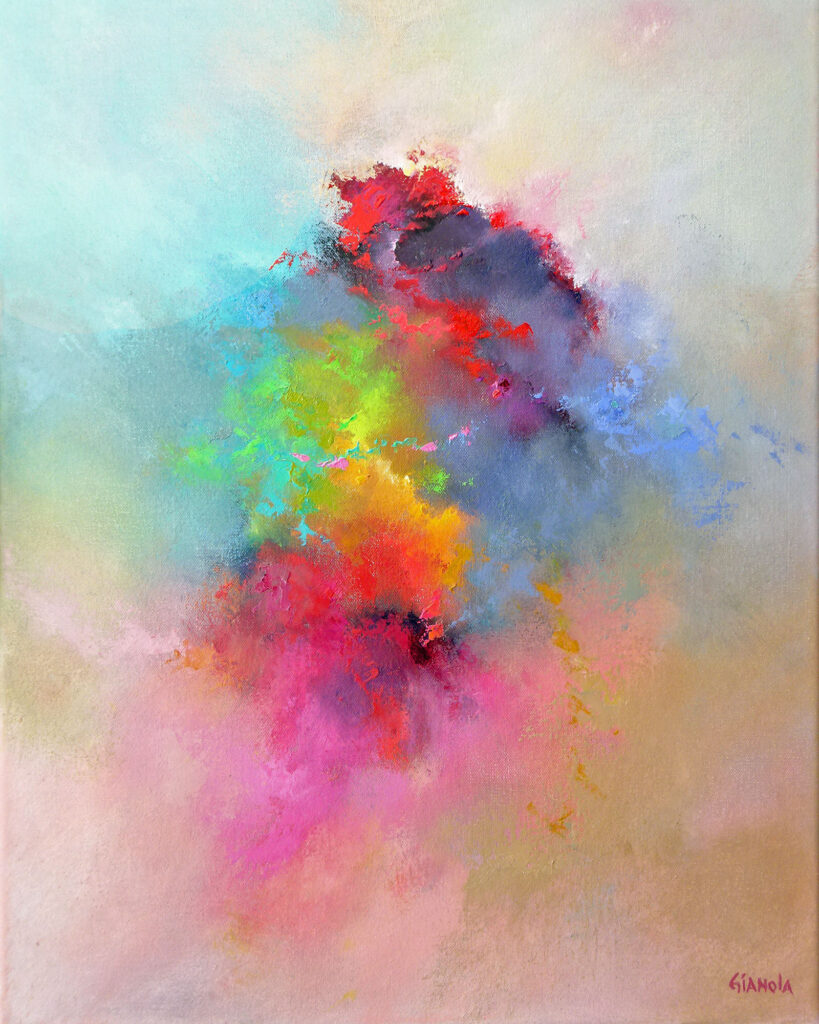
is expressed in Passages #213, painted this year.
HONOR, MI — The one unmistakable element in Ron Gianola’s arresting “Passages” paintings is his command in brush, knife, and single pigment colors to produce abstract images endowed with energy and motion. The Passages collection, which Gianola started about a decade ago, has a readily available narrative expressed by freedom from constraint and realized through free form rhythm. The paintings are a visual declaration, much like Gianola’s other artistic expression as a jazz drummer. The immediate effect is like watching clouds changing shape in a wind-blown sunset.
Some 65 of Gianola’s paintings, which measure his evolution from auto industry draftsman to portraiture to landscape painting to reach artistic prominence with his unique Passages canvasses, have been on display since September at the Dennos Museum Center at Northwestern Michigan College in Traverse City. The exhibition also features Stephen Duren, a noted West Michigan landscape artist, and 10 artists connected to the Tusen Taak Foundation, a Leelanau County artist residency program. The Dennos show closes on January 7, 2024.
If art defines the artist then the bright blending of movement, fine skill, precision, and resolve in Passages is an apt reflection of Gianola. It’s all interesting, determined, and under control. He is 73 years old and has spent a lifetime exploring his artistic instinct even as he understood the need to support himself financially as a well-recognized machine tool designer and draftsman in Michigan’s auto sector. The older of two sons, he was raised on Detroit’s working class east side. Even before he graduated from Cass Technical High School he attracted attention for his drawing and design skills and began working in the Detroit auto sector, where he stayed, mostly as a freelancer, until the Great Recession in 2008.
“I was a car nut,” he said in an interview. “That’s what I wanted to do. Work in styling. I had an uncle that was a model maker. I just grew up in that culture.”
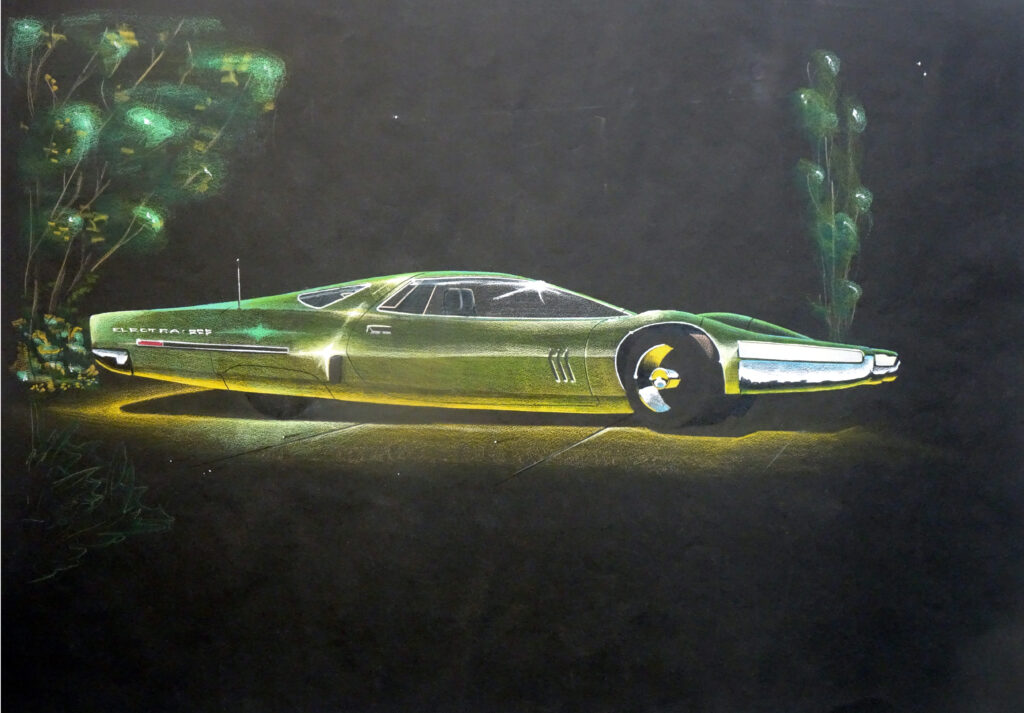
With the other side of his creative instinct he sought excellence in fine art and music. Detroit’s jazz musicians sought him out as a drummer. And with wages earned as a designer, he studied art and began painting at the Art School of the Detroit Society of Arts and Crafts, a private art and design college now known as the College For Creative Studies. “I was starting to draw figures at Arts and Crafts,” he said. “Even if you’re in industrial design you should have a fine art background. You should have art history. Basic design. Basic color. Photography. History of material. The whole bit, right? So I was somewhat in fine art at that point including figure drawing, which I had never done in my life. And I thought whoa, how did this happen? This is too weird even for me? But I was good at figure drawing. And I just fell in love with art.”
He also fell in love with his wife, Pam Yee, and eventually made the move to Benzie County. They’d known each other as teenagers, where Yee also attended Cass Tech and graduated in the same class before going their separate ways. She raised two sons and worked as a Wayne County Circuit Court clerk . The two reconnected at their 10th high school reunion in 1978, and married in 1986.
During that period and afterward Gianola and Yee also made regular visits to Benzie County, spending summer weeks on Platte Lake. In 1990 they paid $40,000 for a house along the Platte River upstream of Honor that Ron renovated during weekend trips from Harper Woods. He later added a second floor. He also renovated what he called “a complete, uninhabited, abandoned wreck” of an outbuilding next door for his studio. In 1995 the river house became their permanent residence and work place.
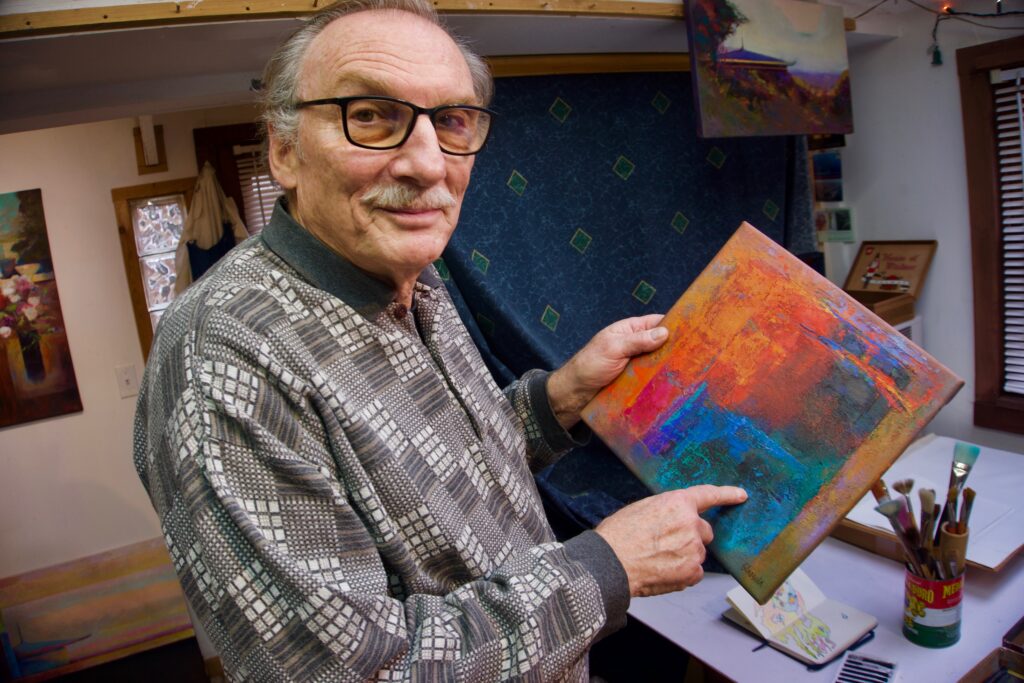
While dial-up internet service kept his drafting clients happy, and his income stable, the change in lifestyle and geography had immediate effects on Gianola’s painting. Gianola specialized in Benzie landscapes. “It’s here. It’s beautiful. It’s for all the reasons we’re all here,” he said. He and Yee also spent time in Hawaii, where he met Lau Chun, a renowned impressionist landscape painter, and studied Chun’s use of color.
In 1995 he produced “Summer Serenade,” an impressionist triptych of the garden outside his cozy, sunlit studio. It exhibited Gianola’s maturing craftsmanship and detail, and his understanding of Chun’s color techniques. It was his first masterwork and was chosen by Gov. Jennifer Granholm to hang in the Governor’s Mansion in Lansing.

The path from past pursuits to artistic excellence is seldom short, direct, or free of complications. In 2007 and 2008 the Great Recession hammered the auto industry. Drafting work dried up. Nearing 60, Gianola retired from his auto industry work and devoted more time to painting. He began to experiment with interiors and geometric shapes and more color-infused abstract images. Gradually something new and distinctive began to emerge from Gianola’s easel. He called them “Passages,” a reflection of his evolving artistic passion and the intensity of the freedom he was experiencing with his life in the woods.
Passage canvasses were infused with the elusive motion and sound of a fast-flowing river. The art wasn’t primordial or reckless or abandoned. Rather it was tightly constructed even as it exclaimed excitement and celebration. Passages was the work of a thinking man who freely creates, with the result that when he finished, the canvas examined the artist’s presence and his exhilaration. In 2014, Gianola painted Passage #82, another triptych and a masterwork that embodied the beauty and charisma of the collection.
“I tried to paint like Lau for 12 years,” Gianola said. “In the end I never wound up painting like Lau. But much better, I wound up painting like me, because I worked so hard. Trying to do what I thought Lau was doing I learned all this technique that I wasn’t paying any attention to. And one day I woke up and I thought ‘Well, you know what? That doesn’t look like Lau. That looks like a great painting that I didn’t intend to do.’
“You know, you struggle and try so hard to get there that you learn some other stuff on the way. After 50 years you’ve actually learned a few things.”
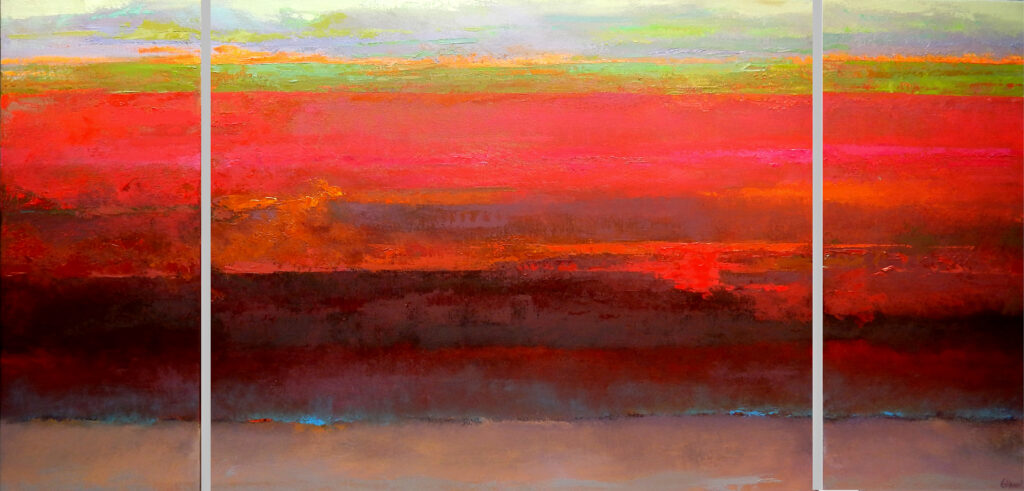
Passages elevated Gianola’s work to prominence and stature that only a handful of Benzie County artists have achieved. Among them are Gwen Frostic, the nature block print maker, Roland Roycraft, the landscape water colorist, and Dewey Blocksma, an avante garde sculpture artist. The leaders of the Dennos Museum certainly understood what was happening in Gianola’s studio and invited him to display Passages this year. Hung in the Dennos Museum in September, patrons studied the deep reds and skyline colors of Passage #82 and marveled at its power.
“Ron continues to find new ways to explore themes and ideas that excite him. That’s what really got us interested,” said Craig Hadley, the Dennos Museum director and chief curator. “And we’ve never mounted a solo exhibit of his work. That was appealing as well.”
The solo exhibit at the Dennos, one of Michigan’s finest art museums, is a peak experience in Gianola’s life and his art career. It delivered the public recognition and approbation that Gianola has merited for years. What’s next? Gianola isn’t clear on that question. “I’m content,” he said. “I did what I wanted to do or what I felt I should do, which for the longest time seemed kind of impossible. I didn’t have enough time. I was working in this crazy engineering business. It just seemed like chaos. I had to show the world that there was a poetic side to me.”
— Keith Schneider
